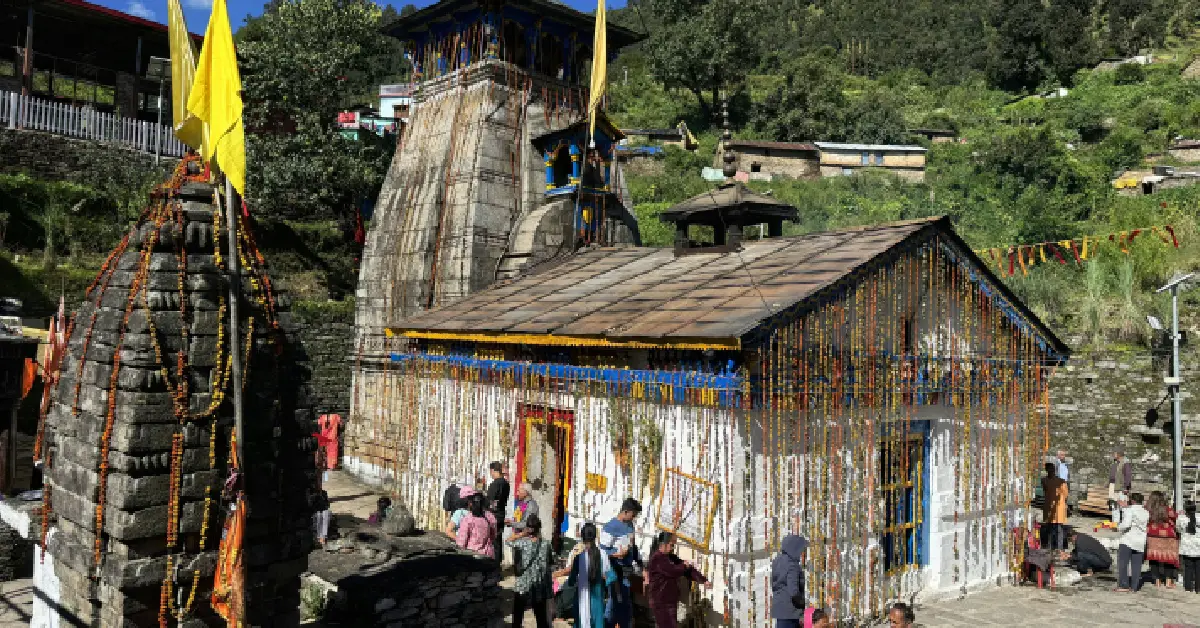In the heart of the serene Garhwal Himalayas, nestled amidst breathtaking peaks and lush valleys, lies a temple steeped in ancient legend and revered as the sacred venue of Lord Shiva and Goddess Parvati’s divine wedding – the Triyuginarayan Temple. More than just a place of worship, this temple, located in the Rudraprayag district of Uttarakhand, India, holds immense spiritual significance and draws devotees from far and wide, eager to witness the echoes of this celestial union.
A Witness to Eternity:
The name Triyuginarayan itself holds profound meaning. It is derived from three words: “Tri” (three), “Yugi” (eras or yugas), and “Narayan” (Vishnu). This name signifies that Lord Vishnu witnessed the holy matrimony of Shiva and Parvati in all three yugas – Satya Yuga, Treta Yuga, and Dvapara Yuga. The temple’s association with all three yugas underscores its timeless importance and its connection to the very fabric of Hindu cosmology.
Legend has it that this sacred spot was once a place of intense penance. Goddess Parvati, in her previous birth as Sati, performed rigorous austerities to win Lord Shiva’s favor. Her unwavering devotion eventually led to their divine union, which was solemnized at this very location. Lord Vishnu, in his Narayan form, graced the occasion as a witness, lending his name to the temple and solidifying its sanctity.
The Eternal Flame:
One of the most captivating aspects of the Triyuginarayan Temple is the Akhand Jyoti, the eternal flame that has been burning continuously for ages. It is believed that this sacred fire has been witnessing the rituals and prayers of devotees since the time of the divine wedding. The flame, housed within a specially designed structure, is a focal point of worship, symbolizing the enduring nature of the divine union and the unwavering faith of the devotees.
The Akhand Jyoti is not just a flame; it is a tangible link to the ancient past, a reminder of the divine presence that permeates this sacred space. Devotees offer their prayers to the flame, seeking blessings for marital bliss, longevity, and spiritual growth. The flickering light of the Akhand Jyoti serves as a beacon of hope, illuminating the path of devotion and inspiring a deeper connection with the divine.
Architectural Splendor:
The Triyuginarayan Temple, though not as grand as some of the larger Himalayan shrines, possesses a unique charm and architectural simplicity that reflects its ancient origins. The temple’s structure is primarily constructed from stone, with intricate carvings and embellishments that depict scenes from Hindu mythology. The main shrine houses the idols of Lord Shiva and Goddess Parvati, beautifully adorned and revered by devotees.
The temple complex also includes smaller shrines dedicated to other deities, further enhancing its spiritual significance. The serene atmosphere and the natural beauty surrounding the temple contribute to its overall appeal, creating a space where devotees can connect with the divine in a tranquil and inspiring environment. The architecture, though simple, speaks volumes about the enduring faith and the rich cultural heritage associated with the temple.
A Journey of Faith:
The pilgrimage to Triyuginarayan Temple is not just a physical journey; it is a journey of faith, a quest for spiritual purification and divine blessings. The arduous trek to the temple, though challenging, is considered a sacred ritual in itself. Devotees believe that the hardships endured during the pilgrimage are a form of penance, purifying their minds and bodies and making them worthy of the divine grace.
The journey to Triyuginarayan is an opportunity for introspection, a chance to disconnect from the distractions of everyday life and focus on the divine. The breathtaking scenery of the Himalayas, the crisp mountain air, and the serene atmosphere of the temple all contribute to a transformative experience, leaving pilgrims feeling refreshed, rejuvenated, and spiritually uplifted.
The Rituals and Ceremonies:
The rituals and ceremonies performed at Triyuginarayan Temple are deeply rooted in tradition and reflect the ancient customs associated with the divine wedding. Devotees offer prayers to the Akhand Jyoti, circumambulate the sacred flame, and participate in the various pujas and aartis conducted throughout the day.
Special ceremonies are held during festivals and auspicious occasions, attracting a large number of devotees. The atmosphere during these celebrations is electrifying, filled with the chanting of hymns, the ringing of bells, and the aroma of incense. The temple comes alive with vibrant colors, traditional music, and the joyous expressions of devotees, creating a truly unforgettable experience.
The Significance of the Wedding Venue:
The Triyuginarayan Temple’s status as the wedding venue of Shiva and Parvati adds a unique dimension to its spiritual significance. It is believed that couples who visit the temple and offer prayers are blessed with a harmonious and long-lasting marriage. The temple is therefore a popular destination for newlyweds and couples seeking blessings for their marital life.
The temple serves as a reminder of the sacred bond of marriage, the importance of love and devotion, and the enduring nature of the divine union. It is a place where couples can reaffirm their commitment to each other and seek blessings for a fulfilling and prosperous life together.
Preserving the Legacy:
The Triyuginarayan Temple, like many ancient shrines, faces the challenges of preservation and modernization. Efforts are being made to protect the temple’s architectural heritage and ensure its continued sanctity. The local community plays a vital role in maintaining the temple and preserving its traditions.
The temple’s legacy is not just about its physical structure; it is about the stories, the beliefs, and the unwavering faith that have been passed down through generations. It is about preserving the spiritual essence of the temple and ensuring that it continues to inspire and guide devotees for years to come.
A Tapestry of Faith and Legend:
The Triyuginarayan Temple is more than just a place of worship; it is a tapestry woven with threads of faith, legend, and history. It is a symbol of the divine union, a witness to eternity, and a beacon of hope for those seeking spiritual solace. The temple’s significance extends beyond its physical structure, encompassing the rich cultural heritage and the deep-seated beliefs associated with it.
The stories and legends surrounding the temple continue to inspire and intrigue, drawing devotees from all walks of life. The Triyuginarayan Temple is a place where the past and the present converge, where tradition and modernity coexist, and where the human spirit finds connection with the divine. It is a place that will continue to resonate with the faithful for generations to come, a testament to the enduring power of faith and the timeless sanctity of the divine wedding.
Visiting Triyuginarayan Temple:
Reaching Triyuginarayan Temple involves a trek of about 5 kilometers from Sonprayag, which is well connected by road. The nearest airport is Jolly Grant Airport in Dehradun. From Dehradun, you can hire a taxi or take a bus to Sonprayag. The trek to the temple is moderately challenging but offers stunning views of the surrounding mountains and valleys.
The best time to visit Triyuginarayan is during the summer months (May-June) and the post-monsoon season (September-October). It is advisable to avoid visiting during the monsoon season (July-August) due to landslides and difficult trekking conditions. Visitors should dress modestly and carry necessary trekking gear, including comfortable shoes, warm clothes, and rain gear.
A visit to Triyuginarayan Temple is not just a pilgrimage; it is an experience that will stay with you long after you leave. It is an opportunity to connect with the divine in the midst of nature’s grandeur, to witness the echoes of a celestial union, and to immerse yourself in the rich cultural heritage of the Himalayas. It is a journey that will leave you feeling spiritually enriched and deeply connected to the ancient traditions of faith and devotion.
Triyuginarayan Temple FAQs
What is the significance of Triyuginarayan Temple?
Triyuginarayan Temple is revered as the sacred venue of Lord Shiva and Goddess Parvati’s divine wedding. It is believed that Lord Vishnu witnessed their union in all three yugas (Satya, Treta, and Dvapara), hence the name.
Where is Triyuginarayan Temple located?
The temple is situated in the Rudraprayag district of Uttarakhand, India.
Who is the presiding deity of the temple?
The temple is dedicated to Lord Vishnu in his Narayan form, who witnessed the wedding. However, the temple is most famous for its association with the marriage of Shiva and Parvati, whose idols are also present.
What is the Akhand Jyoti?
The Akhand Jyoti is an eternal flame that burns continuously in the temple. It is believed to have been burning since the time of the divine wedding and is a focal point of worship.
How old is the Triyuginarayan Temple?
The exact age is difficult to determine, but it is believed to be an ancient temple, with connections to all three major Yugas in Hindu cosmology.




